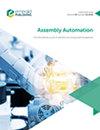动态环境下基于改进A*算法的机器人导航
IF 1.7
4区 计算机科学
Q3 AUTOMATION & CONTROL SYSTEMS
引用次数: 5
摘要
目的提出一种在含有动态障碍物的复杂环境中进行路径规划的方法,该方法提高了传统a*算法的性能,可以在短时间内规划出最优路径。设计/方法/途径为了在具有动态和静态障碍物的复杂环境中规划最优路径,提出了一种新的改进a*算法。首先,通过谷歌网对障碍物进行识别,并将其分为静态障碍物和动态障碍物。其次,将光线跟踪算法应用于静态避障,提出了一种基于扩张原理的动态避障等待规则。第三,提出的改进A*算法包括自适应步长调整、评估函数改进和二次B样条平滑路径规划。最后,在实际环境中对所提出的改进A*算法进行了仿真和验证,并与传统的A*算法和改进的A*方法进行了比较。实验结果表明,在复杂的动态环境中,与传统的A*和改进的A*算法相比,所提出的改进A*算法是最优的,执行时间更短。独创性/价值本文提出了一种基于扩张原理的动态避障等待规则。此外,所提出的改进A*算法包括自适应步长调整、评估函数改进和二次B样条路径平滑操作。实验结果表明,改进后的A*算法可以获得更短的路径长度和更短的运行时间。本文章由计算机程序翻译,如有差异,请以英文原文为准。
Robot navigation based on improved A* algorithm in dynamic environment
Purpose
The purpose of this paper is to put forward a path planning method in complex environments containing dynamic obstacles, which improves the performance of the traditional A* algorithm, this method can plan the optimal path in a short running time.
Design/methodology/approach
To plan an optimal path in a complex environment with dynamic and static obstacles, a novel improved A* algorithm is proposed. First, obstacles are identified by GoogLeNet and classified into static obstacles and dynamic obstacles. Second, the ray tracing algorithm is used for static obstacle avoidance, and a dynamic obstacle avoidance waiting rule based on dilate principle is proposed. Third, the proposed improved A* algorithm includes adaptive step size adjustment, evaluation function improvement and path planning with quadratic B-spline smoothing. Finally, the proposed improved A* algorithm is simulated and validated in real-world environments, and it was compared with traditional A* and improved A* algorithms.
Findings
The experimental results show that the proposed improved A* algorithm is optimal and takes less execution time compared with traditional A* and improved A* algorithms in a complex dynamic environment.
Originality/value
This paper presents a waiting rule for dynamic obstacle avoidance based on dilate principle. In addition, the proposed improved A* algorithm includes adaptive step adjustment, evaluation function improvement and path smoothing operation with quadratic B-spline. The experimental results show that the proposed improved A* algorithm can get a shorter path length and less running time.
求助全文
通过发布文献求助,成功后即可免费获取论文全文。
去求助
来源期刊

Assembly Automation
工程技术-工程:制造
CiteScore
4.30
自引率
14.30%
发文量
51
审稿时长
3.3 months
期刊介绍:
Assembly Automation publishes peer reviewed research articles, technology reviews and specially commissioned case studies. Each issue includes high quality content covering all aspects of assembly technology and automation, and reflecting the most interesting and strategically important research and development activities from around the world. Because of this, readers can stay at the very forefront of industry developments.
All research articles undergo rigorous double-blind peer review, and the journal’s policy of not publishing work that has only been tested in simulation means that only the very best and most practical research articles are included. This ensures that the material that is published has real relevance and value for commercial manufacturing and research organizations.
 求助内容:
求助内容: 应助结果提醒方式:
应助结果提醒方式:


